 Regia Marina: 8 Built 1925-1928, all lost in action before Sept. 1944:
Regia Marina: 8 Built 1925-1928, all lost in action before Sept. 1944:Aquilone, Borea, Espero, Euro, Nembo, Ostro, Turbine, Zeffiro
WW2 Italian Destroyers
Poerio | Aquila | Mirabello | Leone | Sella | Sauro | Turbine | Navigatori | Freccia | Folgore | Maestrale | Oriani | Soldati | Medaglie d’OroWW2 Italian Torpedo Boats
Indomito | Audace | Audace(ii) | Pilo | Sirtori | La Masa | Generali | Palestro | Curtatone | Albatros | Spica | Pegaso | Ciclone | ArieteThe Turbine-class destroyer was a group of eight destroyers of the Regia Marina built in the late 1920s. They were an extrapolation of the previous Sella/Sauro but with more steam power for greater top speeds and more range. They really were a maturation of earlier designs inherited from the 1918 Curtatone-Palestro. They are also the last of this design lineage. They played a minor role in the Spanish Civil War in 1936–1937 supporting the Nationalists and saw heavy action from June 1940, all being lost during World War II to various causes, including four in Tobruk (air attack by Eagle), two in Benghazi (by Illustrious), one at Leros and another at Salamis. Nembo, Ostro and Zeffiro by British airborne torpedoes (Swordfish food). Borea and Kuro bombed, the former by British, and the latter by German aircraft. Turbine was seized by the Germans in September 1943, renamed TA14, and was later sunk by US aircraft at Salamis.
Design of the class
Development
The Turbine class destroyers were a real leap forward in design and marked the start of a more standardized approach, with more ships built from the same design, improving on the power output for extra speed and range, while keeping the same armament as previous classes. The Turbine-class were essentially enlarged and improved versions of the Sauro class but lengthened to see the installation of a more powerful propulsion machinery than earlier destroyers, and provide extra space for larger fuel oil bunkerage, increasing endurance. Once the design approved in 1924 they were all ordered for 1926, laid down in late 1925.
So essentially, they were a repeat of the Sauro class, except for a slight increase in length and higher powered machinery for an additional 1 knot in design speed. Laid down in 1925 they were launched in 1927 and completed 1927-28. Early war modifications included the removal of the 40mm guns and the addition of about 8-20mm AA and 2 DC throwers. Turbine later had one TT mounting removed and 2-37mm/54 AA (2×1) added.
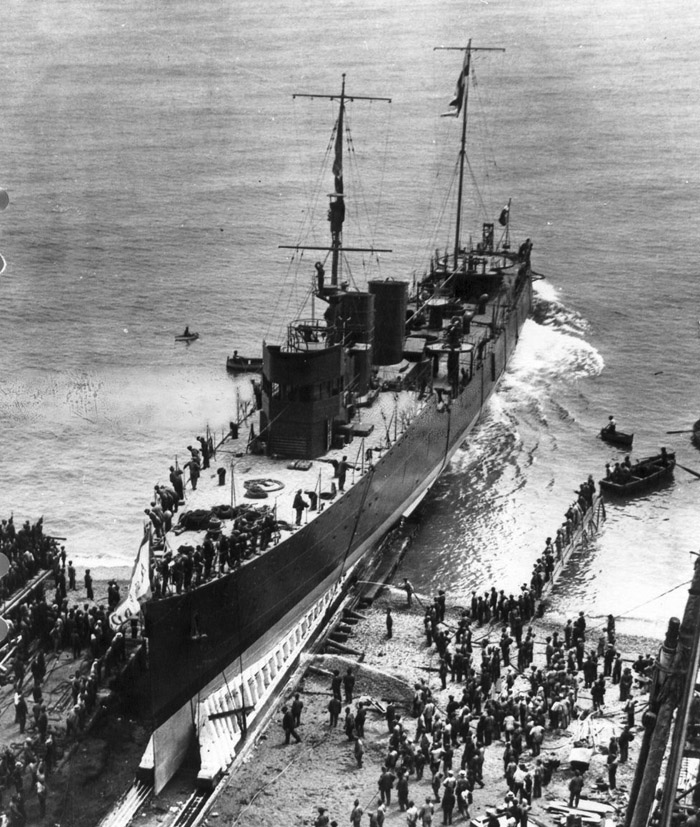
Launch of Zeffiro
Final Characteristics
Hull and general design
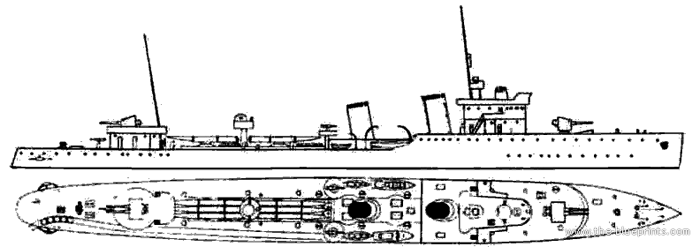
The Turbine class had an overall length of 93.2 meters (306 ft), for a beam of 9.2 meters (30 ft 2 in) and mean draft of 3 meters (9 ft 10 in). They were thus significantly larger than the previous Sauro class, but kept the same general outlook. They displaced 1,090 metric tons (1,070 long tons) at standard load, 1,700 metric tons (1,670 long tons) deep load, the Sauto were 1040/1575t in comparison, the Sella 955/1457t. Their complement was 12 officers and 167 enlisted men so a beefier crew than beforr, notably due to the better AA armament.
The Turbine Class ships had characteristics that can be defined as intermediate between the ships of the first post-war period and those of the thirties. They were launched in the two-year period 1927-28, and compared to their predecessors they had a hull lengthened by 3 meters, so as to be able to accommodate a propulsion system 10% more powerful.
The general profile was about the same however, with an almost straight prow, rounded poop, a 2/5 length forecastle, a still well flared bow, a somewhat beefier and taller bridge, still single post mast with spotting top, aft mast also raked an lower, raked funnels and same placement and structures for the two torpedo tube banks and radio house aft, plus as for previous designs, the aft M1926 twin gun mounts were placed higher up on the structure’s roof.
These ships were the last if this design, mostly unchanged since the Palestro class.

Aquilone in port
Like the Sauro, they had a very unusual feature for a destroyer, namely a (lightly) armored command tower, although of unknown thickness. For the first time, however, they had a second fire control station for the artillery, placed between the 2 triple torpedo launchers, too low however to make valid use of it in every practical situation as its arc was barred by the funnels and bridge. It would have been possible if better placed, to engage two targets simultaneously.
Powerplant

The propulsion system consisted of two Parsons steam turbines sets, driving two shafts, and fed by three Thornycroft boilers with one exahsuting on the aft funnel and two in the forefunnel, which was larger. The power output was unmatched so far for an Italian destroyer at 40,000 hp (to compare the 2200 Leone class had 42,000 hp for 33 knots), for a top speed as contracted of 36 knots, which seemed a bit optimistic but was mostly met. Indeed, on trials, the design power was greatly exceeded, and Euro achieved 38.9kts on 4-hour full-power and Turbine, in a mile run with 51,214 hp, reached 39.5kts.

Best sea speed was 33kts. It shoud be noted if they reached speeds in excess of 36 knots (67 km/h; 41 mph) in sea trials this was lightly loaded. The service speed was 33 knbots in favourable conditions, calm sea and light breeze.
The autonomy was increased thanks to 274 tonnes (270 long tons) of fuel, for 3,000 km at 20 knots or 3,200 nautical miles (5,900 km; 3,700 mi) at a speed of 14 knots (26 km/h; 16 mph). Other sources gave use a maximal capacity of 400 tons. The Sauro carried 230t for 3000 nm.
Armament
The Turbine class reproduced the exact same armament as the Sauro class, with two twin main guns fore and aft, two triple torpedo tubes, and same AA as planned, with two 40mm Vickers-Terni (WW1 pompom) and twi Breda single 13.2 mm heavy machine guns, and rails for mines. This AA was still unsufficient in 1940. They apparently had depht charges and hydrophones albeit the detail is uncertain.

Launch of Nembo
Cannone da 120mm/45 OTO Modello 1926
Mount: 16.6 tons (16.9 mt), training c+150/-150 degrees, +33° elevation
Shell: Type Bag, HE 48.5 lbs. (22 kg), AP 51.0 lbs. (23.15 kg), charge 16.75 lbs. (7.6 kg)
Muzzle Velocity: 2,789 fps (850 mps).
Range: 48.5 lbs. HE shell/33 degrees: 16,950 yds (15,500 m)
Rate of fire: 7 rpm
These mounts had the barrels 22.8 in (58 cm) apart and like many other Italian ships, suffered from dispersion problems.
Subsequent classes would adopt the 120mm/50, with a greater range and rate of fire. Thus arrangement allowed a much greater compactness in design and certainly contributed to the aesthetic harmony of the design, more compact but this choice made the barrels interfering with each other during firing. That dispersion haunted the navy’s technicians throughout the war.
2-in (40mm/39) Vickers-Terni M1917
In short, this was an Italian copy of the 2-pounder “pompom”. It was called Vickers-Terni modello 1915/1917, exact caliber 1.573 inches. Carried by the Sella, Sauro, Turbines, Navigatori classes. The mount was the M1930 1,878 lbs. (852 kg) capable of +80 degrees, manual, with five operators and steel-link belts.
Specs:
Weight 550 lbs. (249 kg) including cooling water
Overall lenght 96 in (2.438 m), bore 62 in (1.575 m), 200 rpm cyclical, 50-75 rpm practical
Fired the HE or CP rounds of 2.95 lbs. (1.34 kg) at 2,000 fps (610 mps).
Maximum Effective Range: 1,200 yards (1,100 m)
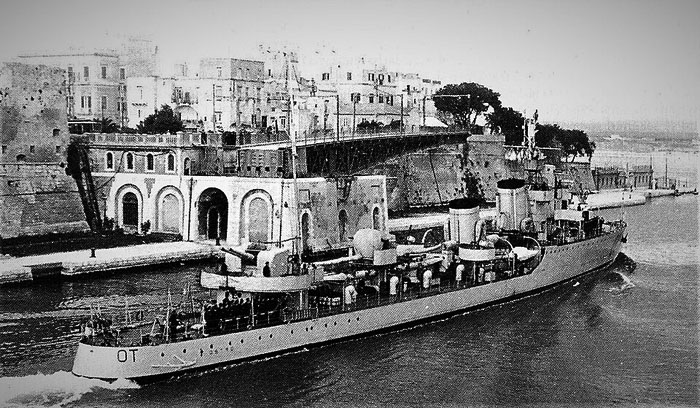
Ostro rear view
Breda 13.2mm/76 HMG
No info if anterior to the modello 13.2 mm/75.7 (0.52″) AA MG or Model 1931.
Specs (Modello 1931)
Gun Weight: 104.5 lbs. (47.5 kg), Bore Length 39.4 in (1.000 m). 500 rounds per minute cyclic.
Fired 5.4 in (13.7 cm) 0.28 lbs. (0.125 kg) rounds at 2,592 fps (790 mps), effective range: 2,200 yards (2,000 m).
533 mm Torpedoes
These were the first destroyers with 120 mm main guns and 533 mm torpedo tubes, on par with their competitors. In fact rival France had even larger torpedoes at 550 mm. They were in two axial banks aft.
They were likely given the 53.3 cm (21″) Si 270/533.4 x 7.2 “M” model. This was a model manufactured in Naples (Silurificio Italiano).
There were no reloads.
Specs:
Weight; 3,748 lbs. (1,700 kg)
Overall Length: 23 ft. 7 in. (7.200 m)
Warhead: 595 lbs. (270 kg)
Range/Speed settings: 4,400 yards (4,000 m)/46 kts, 8,750 yards (8,000 m)/35 kts, 13,100 yards (12,000 m)/29 kts
Powered by Wet-heater. Later versions went to 48/38/30 knots on the same ranges settings.
Mines
The ships carried also 50 mines as well during wartime, far more than the Palestro/Curtatone, either the Vickers Elia (VE) 1,676 lbs. (760 kg), 320 lbs. (145 kg) WH, or Sautter-Harlé types M1916 154 or 220 ib.
Modifications
They were limited. In 1939-1940, Euro and Turbine saw the replacement of their “pompom” for four twin 20ùù/65 Breda 1935 and the installation of two depth charge throwers. In 1942, Turbine saw the removal of her aft TT banks for the installaiton insteal of two single 37mm/54 Breda 1939 AA guns. Their early loss did not authorized much in terms of modernization. In terms of protection, compartmentation was unsufficient as seen with the loss to single 45 cm (18 inches) torpedoes from Fairey Swordfish.

⚙ specifications |
|
| Displacement | 1,090 t (1,070 long tons) (standard), 1,700 t (1,670 long tons) full load. |
| Dimensions | 93.2 x 9.2 x 3 m (305 ft 9 in x 30 ft 2 in x 9 ft 10 in) |
| Propulsion | 2 shafts GST, 3 Yarrow boilers 40,000 shp (30,000 kW) |
| Speed | 33 knots (61 km/h; 38 mph) |
| Range | 3,200 nmi (5,900 km; 3,700 mi) at 14 knots (26 km/h; 16 mph) |
| Armament | 2×2 120 mm, 2× 40 mm, 4×2 13.2 mm, 2×3 533 mm, 52 mines |
| Crew | 179 |
Evaluation
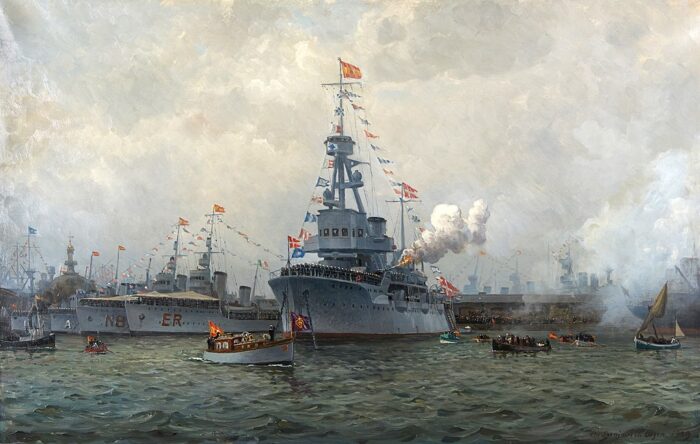
Christian Olsen: HDMS Niels Juel in Barcelona, Turbine class destroyers present.
 At the start of the war in June 1940, the class was dispersed, a part detached in Africa, under the Naval Command of Libya and another with the District of the Lower Adriatic, also responsible for the Ionian Sea. Turbine was leader of the 1st squadron, comprising also Aquilone, Euro and Nembo, based in Tobruk. Espero was leader of the II squadron also comprising Borea, Zeffiro and Ostro, based in Taranto.
At the start of the war in June 1940, the class was dispersed, a part detached in Africa, under the Naval Command of Libya and another with the District of the Lower Adriatic, also responsible for the Ionian Sea. Turbine was leader of the 1st squadron, comprising also Aquilone, Euro and Nembo, based in Tobruk. Espero was leader of the II squadron also comprising Borea, Zeffiro and Ostro, based in Taranto.
In 1940 many saw them as already very outdated, as theur design went back to 1924. Small and old, without much room for addition, they were still fast and with a good range, and by default used in action and quickly “exterminated”. Espero was sunk off the coast of Libya, an easy prey for the 6-in guns (152 mm) of the Australian light cruiser HMS Sydney on 28 June 1940 in the little known Battle of the Espero Convoy. This was a surprise attack by a whole formation and, the captain sacrificed his ship by maneuvering to protect the retreat of her sisters Ostro and Zeffiro, allowing them to disengage and reach Benghazi safely. Commander, Enrico Baroni received the pothumous Medaglie D’Oro (Gold Medal) for Military Valor.
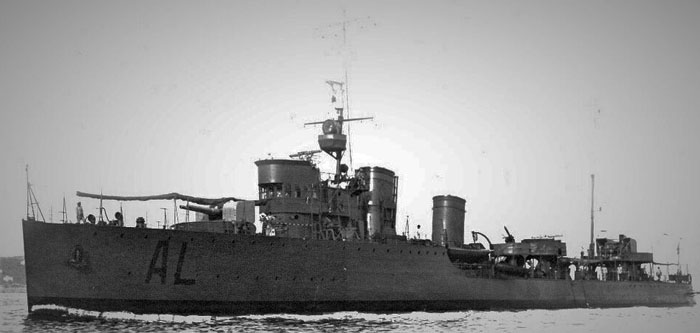
Aquilone in her early interwar dark gray livery
 After a week on July 5, the bay of Tobruk saw one of many successful air attacks that cripple dthe Regia Marina at large end eventually pushed Supermarina (The general command) to pushed for the adoption of an aircraft carrier, despite the initial opposition of Mussolini. Zeffiro was sunk and Euro bacly damaged by a Fairey Swordfish attack from the old HMS Eagle, also sinking a merchant ship in the process. They proved the inadequacy of their AA battery. After 15 days on July 20, a similar attack in the Gulf of Bomba (well named…), they sank another transport and the destroyers Ostro and Nembo. Later, 12 land-based aircraft, bombed and sank two Sauro-class destroyers a year after. Borea and Aquilone were sunk on the night of September 17, 1940 in Benghazi, by more Swordfish belinging this time to the aircraft carrier Illustrious. Thus by late 1940, the class was reduced to just two ships, reduced to marginal roles since there were not enough to form a proper squadron.
After a week on July 5, the bay of Tobruk saw one of many successful air attacks that cripple dthe Regia Marina at large end eventually pushed Supermarina (The general command) to pushed for the adoption of an aircraft carrier, despite the initial opposition of Mussolini. Zeffiro was sunk and Euro bacly damaged by a Fairey Swordfish attack from the old HMS Eagle, also sinking a merchant ship in the process. They proved the inadequacy of their AA battery. After 15 days on July 20, a similar attack in the Gulf of Bomba (well named…), they sank another transport and the destroyers Ostro and Nembo. Later, 12 land-based aircraft, bombed and sank two Sauro-class destroyers a year after. Borea and Aquilone were sunk on the night of September 17, 1940 in Benghazi, by more Swordfish belinging this time to the aircraft carrier Illustrious. Thus by late 1940, the class was reduced to just two ships, reduced to marginal roles since there were not enough to form a proper squadron.
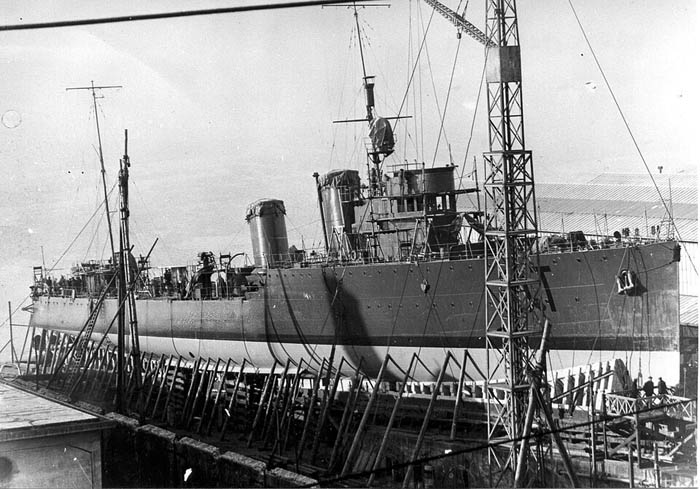
Launch of Ostro
They managed to survive until the armistice, but not to the end of the war: Euro, already damaged in the battle of the Duisburg convoy on September 1943, was sunk by German aircraft when trying to reach southern Italy from the Aegean on 1st October. Turbine, the clas leader and ironically sole survivor of her class and modernized with extra AA, was captured by the Germans in Piraeus, impressed as TA-14. After many missiones she was sunk by US aviation by September 1944 while anchores in Salamis, Greece.
All these ships, except Espero, were hit by aviation, demonstrated their inadequate anti-aircraft armament. This was the case for many other ships of that category dating back pre-war. These ships were also unlucky, cornered in situations without escape. They were buiot with few redundancy as proved by the damage inflicted by aerial torpedoes or even bomb near-misses and just not qualified to survive new threats of the modern naval air warfare.
Career of the Turbine class
 Aquilone
Aquilone

Aquilone was laid down at Odero, Sestri Ponente Naval yard on 18 May 1925, launched on 3 August 1927, completed on 3 December 1927. Upon completio she joined her sisters Turbine, Nembo and Euro in the 2nd Squadron, I Destroyer Flotilla, II Naval Division at La Spezia. Between 1929 and 1932 she trained and cruised in the Mediterranean. In one of these, she accidentally launched a torpedo and hit Zeffiro, whuch was fortunately a dud. By 1934 after a reorganization Aquilone she ended in a 8th Destroyer Squadron, still II Naval Division. In January 1938 she was moved to Brindisi, then Tobruk, Libya from March. She started training cruises in the eastern Mediterranean until 1939, stopping in Albania, Greece and Crete and escorting Italian submarines via Port Said to East Africa. She also had storm damage. In November 1939 she was back to Brindisi to unload ammunition and entered Fiume for a prewar refit. In March 1940 she was back to Brindisi to load ammunition, then Tobruk in April, and on May 20 she laid a protective minefield around Tripoli, Benghazi, Tobruk and others until June-July.
From June 10, her 1st Destroyer Squadron was still based in Tobruk and she was under command of Captain Alberto Agostini.
On June 12 she was caught in port by a British air strike by Blenheims from 45, 55, 113 and 211 Squadrons. Some were short down by CR.32s from 92nd, 93rd and 94th Squadriglias and the bombing was inefficient. Aquilone had one radio-operator wounded by shrapnel.
It was decided to send the squadron to bombard Sollum, covered by the Regia Aeronautica (12 SM.79 bombers) on June 14. The shelling lasted from 03:49 to 04:05 (220 shells), but poor results due to heavy fog. Another was performed on June 26 with “considerable effectiveness” as reported, 541 shells landed.
On June 29, Aquilone search to rescue men from Espero, but instead was spotted and attacked by a British flying boat.
On July 5, 1940, they were overflown while berthed in Tobruk by a lone a Short Sunderland in recce, reportng for the RN, which later sent nine Fairey Swordfish from 813 NAS from Sidi Barrani, attacking at 20:20. They managed to sink 5 Italian ships. Aquilone was unscaved.
On 19 July 1940, British command decided to finish off the cruiser Giovanni delle Bande Nere taking refuge in Tobruk after the Battle of Cape Spada. At 17:00 twelve Bristol Blenheim bombers from 55, 211 Sqn bombed the northern part of the harbor. At 18:56 a seaplane from Warspite made a recce, confirmed poor results, but was dealt with by AA. At 22:30 six Fairey Swordfish from 824 NAS RAF made an attack under heavy AA fire, just to acquire targets. The attack resumed at 01:30 on July 20, claiming the steamer Sereno, then Ostro. Aquilone was showered by burning debris. Nembo was later also sunk.
Suprmarina considered thus Tobruk to exposed to enemy air attacks, and all assets were shifted to Benghazi, with small coastal convoys. In August and early September she patrolled outside Benghazi and escorting some ships. Benghazi was attacked on September 16 by HMS Valiant, Kent, Calcutta and Coventry, seven destroyers and HMS Illustrious from Alexandria. Aquilone was berthed this day close to Borea and Turbine and there were 32 ships present. The attack proceeded on the 16-17th nigh with a first wave of nine Swordfish (815 Sqn RAF, bombs and torpedoes), six from 819 Sqn with mines, from Illustrious. Gloria Stella, Cigno, the tug Salvatore Primo and auxiliary Giuliana were damage dor sunk. The second wave claimed Maria Eugenia and the destroyer Borea. Had a bomb near-miss but had no more damage. The problem were the mines laid undetected 75m outside the harbor entrance. The Libyan Naval Command (Comando Marilibia) decided to evacuate Benghazi and the first ship departed at 11:38 escorred, only to hit and be towed back into port. The area was dredge and a cleared channel was opened to exit.
Aquilone and Turbine left at 20:15, Turbine leading. At 20:45, Aquilone struck two magnetic mines amidship and stern. She started veering to port, towards the coast and believing it was a night attack, AA gunners opened up. Turbine was ordered to left her and proceed to Tripoli. Her rudder stuck, Aquilone sank in 5 minutes but was orderly abandoned, having 4 killed, 9 missing and 20 wounded.
 Borea
Borea

Borea was laid down at Ansaldo NyD in Genoa on 29 April 1925, launched on 28 January 1927, completed on 14 November. At first she was in the 5th Destroyer Squadron and in 1928 trained in the Tyrrhenian Sea, then joining Espero, Ostro and Zeffiro in the 1st Squadron, I Destroyer Flotilla, La Spezia. In 1928 she was in Ibiza, then Tripoli in 1929. In 1930 she was in the Aegean Sea, stopping at Nafplion, Thessaloniki, Rhodes. In 1931 with her sisters and Daniele Manin, Giovanni Nicotera and Pantera formed 1st Destroyer Flotilla, II Naval Division. In 1934 she was in the 4th Destroyer Squadron.
She performed four missiones in the Spanish Civil War by the autumn 1936. In August–September 1937 she took part of the blockade in three missions. By the summer 1938 she was based in the Balearic Islands. From 1938 she was relocated to Tobruk and in 1939 she took part in the invasion of Albania.
By 10 June 1940 with ehr sisters Espero, Ostro and Zeffiro, she was in the 2nd Destroyer, Taranto, in escort duties from Sicily to Libya.
On 30 June she escorted a large convoy from Augusta (six cargo-passenger ships, 6 destroyers), overflew en route by a Short Sunderland. In Torbruk the port was attack by nine Swordfish (see above). Zeffiro was attacked first and the Freighter Manzoni was also hit, as well as Euro and the steamer Serenitas, beached, ocean liner Liguria. She remaiend unscaved.
On 13 September Sollum fell, adn she was moved to Benghazi, raided on 16 September with ywo waves of Swordfish from Illustrious on 16-17 September 1940. Borea was targeted in the second attack, with first ner-miss between her and the steamer Città di Livorno. Soon she had a bomb hit, on her port side which penetrated all the way into the hold, broke her keel. Rapid flooding saw her sinking in shallow waters. Most of the crew abandoned ship with a single casualty, a sailor sleeping in the engine room close to the explosion.
 Espero
Espero
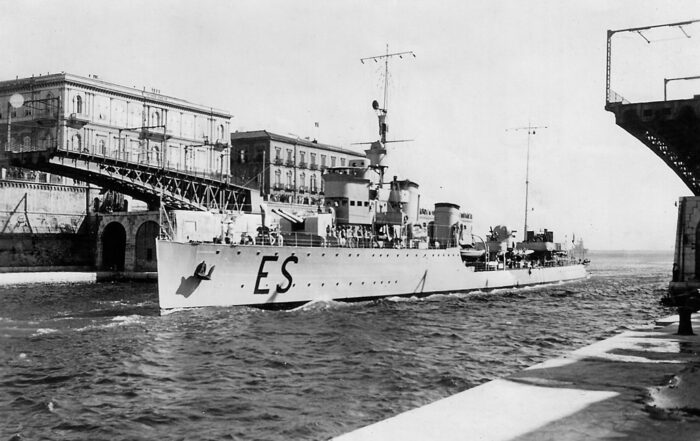
Espero was laid down at Ansaldo on 29 April 1925, launched on 31 August 1927, and completed on 30 April 1928. Like her sisters she was in the 1st Squadron, I Destroyer Flotilla, La Spezia. After the Shanghai Incident in January 1932 Italy sent troopships with the San Marco Battalion to protect the Italian concession in Shanghai with the cruiser Trento sent in escort, with Espero. They left Gaeta on 5 February under command of Admiral Domenico Cavagnari and arrived on 4 March, Espero however stopped at Saigon due to rough weather, and arrived three days later. A truce was negotiated and Trento left Shanghai on 14 May, Espero stayingd behind for a year to make the Italian Far East squadron. In 1934, Espero, Ostro, Zeffiro and Borea formed the 4th DS, 2nd Naval Division. By 10 June 1940 she was now in the 2nd Destroyer Squadron, Taranto.
On 27 June under Captain Enrico Baroni she sailed from Taranto escorting transports to Tobruk loaded with AA batteries and 120 short tons (110 t) of ammunition and the Voluntary Militia for National Security. On 28 June off Zakynthos they were spotted by a Sunderland, close to the 7th Cruiser Squadron (HMS Liverpool, Orion, Neptune, Gloucester, Sydney under Admiral John Tovey). They were spotted at 18:30 100 miles north of Tobruk, and the duel started at 18:36 by HMS Liverpool opening fire from 22,000 yd (20,000 m) followed by Orion. The Italian destroyrs, burdened by heavy cargo were not faster. Espero’s third boiler also was shut down after problems, so she was stuck to 25 knots and Captain Baroni decided to sacrifice his ship to cover the escape of Zeffiro and Ostro, to Benghazi at full speed. Espero laid smokescreens and started evasive maneuvers, engaging the cruiusers with artillery and firing three torpedoes at Orion, buy missed, too far. Liverpool and Gloucester then concentrated on her, the other trying to catch Ostro and Zeffiro, under ordered to abandon and return to sink Espero. The destroyer zieg-azgged frantically, lossing more speed, and at 19:20 she started tio be mauled down from 14,000 yd (13,000 m), after landing a 4.7 in (120 mm) on Liverpool 3 ft above the waterline. She had the first hit at 20:00 in the engine room, bringing her to full stop. Hell broke loose as she was finished off by 5,000 shells over 130 minutes before she sank. Sydney rescued 47 out of 225 men, 36 more escaped on rafts, 6 only later rescued by the submarine Topazio 20 days later. Captain Baroni was posthumously awarded the Medaglia d´oro al valor militare.
 Euro
Euro

Euro was laid down at CNT on 24 January 1925, launched on 7 July 1927, completed on 22 December. In 1932 she was among the first to receive a “Galileo-Bergamini” type fire control unit, designed by the then Captain Carlo Bergamini. She was in reserve from 1935 to 1937 but took part in the Spanish Civil War blockade. In 1938 she was deployed in Cyrenaica and in 1940 with Turbine, Nembo and Aquilone she was part of the I Destroyer Squadron in Tobruk. She was present in the raid on 5 July 1940 and a torpedo hit her, severing her bow. She was towed in shallower water but had more luck than Zeffiro. She had emergency repairs and under command of Giovanni Dessy, she was towed to Palermo, arrived on 6 October 1940, then Taranto for major repairs until March 1941.
On 1 April she sailed for Tripoli with Baleno and Tarigo, TBs Polluce and Partenope escoritng the tropships Esperia, Conte Rosso, Marco Polo and Victoria.
On 30 April with Gioberti, TBs Castore, Procione and Orione she escorted the Birmania, Marburg, Reichenfels, Rialto and Kybfels from Augusta and Messina.
From 5 to 7 May with Fulmine and TBs Procione, Cigno, Orsa, Centauro and Perseo, she escorted Marburg, Kybfels, Rialto, Reichenfels and Marco Polo to Tripoli.
Long story short, the performed other convoys on 16 May, 21 July, 17 August, 26-29 August, 2 October and 8 November 1941. Under commad of Lt.Cdr Giuseppe Cigala Fulgosi from Naples with the convoy “Duisburg” which was attacked and destroyed by the Force K (HMS Aurora, Penelope, 2 destroyers) with all transporst and Fulmine sunk, Grecale badly damaged. Euro was on the starboard side of the convoy, dodged hits and counterattacked with torpedoes until ordered by Captain Bisciani to return tow the convoy, only to be hit by six shells (light damage) and trying her best by laying smoke screens. The following day she tried to two to safety Libeccio, torpedoed by HMS Upholder but she sank. Later she took part in the convoy «Nicolò Odero» for Tripoli. She was modernized in 1942 and by
30 May 1942 she escorted a convoy from Brindisito Libya but they experienced radio issues and lacked coordination. On 31 May, Euro and Allegri were attacked by Vickers Wellington bombers (221st Sqn, RAF) and sank Allegri. Next she was sent to the Aegean, and from 25 February 1943 under Vittorio Meneghini, based in Leros. As armisticewas proclaimed she was underway under orders from Leros command to return in what became the Battle of Leros on 9 September after a reinforcement run to Rhodes before its fall on the 11th.
On 26 September she was in port under two German Stukas attacks, at 9.50 and 15.30, clmaiming also the Greek Vasilissa Olga and HMS Intrepid and MAS 534, Prode and Tananrog seriously damaged. Euro cast off, zig-zaffes in port while AA claimed a Stuka, damaged a second. On 1 October she had near misses damage. On October 3, still in Parteni harbour, she was hit and sank. The crew under Commander Meneghini made a guerilla war against the Germans until the surrender of Leros on November 17 with Commander Meneghini shot.
 Nembo
Nembo
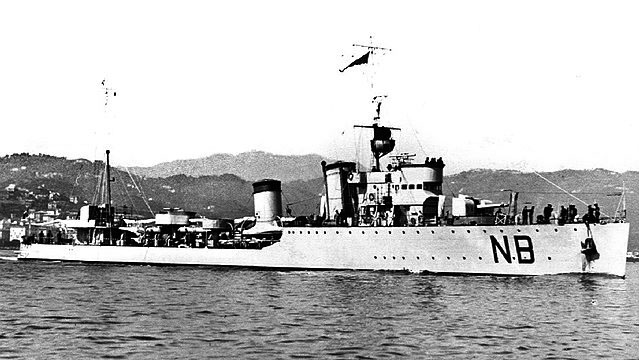
Nembo was laid down at CNT on 21 January 1925, launched on 2 January 1928, completed on 24 October 1927. With Turbine, Aquilone and Euro she was in the 2nd Squadron, I Destroyer Flotilla at La Spezia and trained between 1929 and 1932 in the Mediterranean until passing under the II Naval Division. In 1932 she received a Galileo-Bergamini fire control system, and became flagship of her unit, successfully testing her new system, later installed on all Italian DDs.
In 1934 she was part of the 8th DS, II Naval Division. In 1934 she tested training in Red Sea (tropical tests).
Between 1936 and 1938 she took part in the blockade of the Spanish Civil War. In June 1940 with Euro, Turbine and Aquilone she formed the 1st DS, Tobruk. On June 6, she escorted the minelayer Bartletta laying fourteen minefields (540 mines) around Tobruk. On June 12 she was caught by a RAF air strike, no damage.
She later took part in the first bombardment of Sollum and then second on June 26.
On July 5, she was caught in port by another raid. She was targeted, but the Swordfishes failed to launch their torpedoes due to intense AA fire.
On 19 July 1940 there was a Bristol Blenheim attack, and another Swordfish raid on 22:30. Nembo was hit by a torpedo at 01:37, sank 8 minutes later, with 25 killed, 4 wounded. Her guns and thise from Ostro, also sunk, were later removed to reinforce the defenses of Bardia.
 Ostro
Ostro

Ostro was laid down at Ansaldo SyD on 29 April 1925, launched on 2 January 1928, completed on 9 June 1928 and commissioned on 9 October 1928. Ostro had exercises in the Tyrrhenian Sea, visited Monaco as part of the 1st Squadron, I DF at La Spezia. In 1929 she patrolled off Spain, and in 1930 Dodecanese and Aegean. In 1931 she formed 1st DF, II Naval Division. In 1934, she was in the 4th DS. With the Spanish Civil War from July 1936, she was sent to help the Republicans, hunting down Republican shipping with little success. On 3 August 1937 Franco informed Mussolini of a large Soviet transport convoy which departed Odessa and soon were despatched the cruisers Armando Diaz and Luigi Cadorna, eight torpedo boats and eight destroyers including Ostro, sent in the Strait of Sicily, then Strait of Messina. On 13 August under Captain Teodorico Capone while off Bizerte and Linosa island, she spotted, attacked and sank the Spanish Republican steamer Conde de Abásolo underway from Cartagena to Odessa. She was finished off by a torpedo with 32 of her crew rescued later by the British steamer City of Wellington. This was on of the rare ships sank by the whole Turbine class.
On 30 August she spotted the Soviet steamer Timiryazev, shadowed until darkness fell and attacked by torpedoes at by Turbine, Ostro launching one. She sank east of Algiers. Srvivors were towed to Dellys by local fishing boats. However this was a serious incident as the cargo carried 2,834 tons of coal from Cardiff to Port Said. On 3 September Ostro escorted the Republican freighter Mar Negro from Cagliari to Cape Spartivento to be escorted by the AMC Jaime I to Palma de Mallorca and herself turned into an auxiliary cruiser. In September the Nyon Conference denounced the Italian “underwater piracy” and the Republicans obtained a British and French patrol around Spain, mobilizing 60 destroyers and airforce. Italy had to comply and suspend its submarine and destroyer operations.
On 10 June 1940, Ostro was in the 2nd DS, Taranto and on 27 June 1940 Ostro sailed from Taranto at 22:45 for the first war mission, along with Zeffiro and Espero to Tobruk wth supplies when they were intercepted the following day at 12:10, 50 mi (43 nmi; 80 km) west of Zakynthos by the 7th Cruiser Squadron. Soon the lead ship decided to sacrifice herself, ordering Ostro and Zeffiro to flee under a smoke screen. They arrived on 29 June in Benghazi and then were in Tobruk on 1 July. They left on 30 June from Augusta with troops, supplies, ammunition and fuel, six cargo and troopships escorted her, 5 other destroyers and 4 TBs, not intercepted by the RN. On 5 July 1940 all seven Turbine-class destroyers were berthed in Tobruk during the 813 Naval Air Squadron air raid.
On 19 July 1940 she was still in port when a first raid at 17:00 twelve Bristol Blenheim did little damage, followed by a FAA raid at 22:30 and at 01:30. At 01:34 Ostro was hit in the stern by a torpedo launched by a Swordfish piloted by S. F. Fullmore. Ammunition were ablaze, a detonaton severed the stern and she sank ten minutes later with 42 casualties, 2 officers and 40 ratings missing or KiA, 20 wounded including commander Zarpellon. Her guns were later removed and ended at Bardia.
 Turbine
Turbine
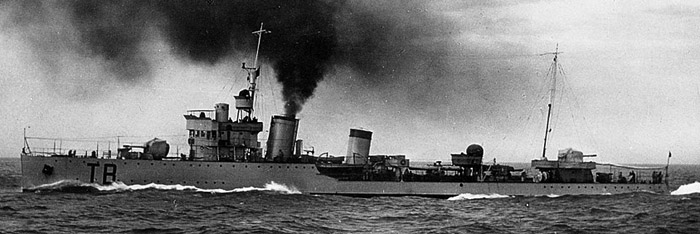
Turbine was laid down at Odero on 24 March 1925, launched on 21 April 1927 and completed on 27 August 1927. With Nembo, Aquilone and Euro she was in the 2nd Squadron, I DF based, La Spezia. Later the 1st Destroyer Flotilla, II Naval Division. In 1934, 8th DS an deployed in the Red Sea for tropical climate training.
In the Spanish Civil War she intervened with other destroyers as submarines had little success to blockade Republican ports, from 3 August 1937. She was signalled a convoy that departed from Odessa and was deployed in the Strait of Sicily and Messina while under command of captain Virgilio Rusca.
On 17 August Turbine and Leone Pancaldo spotted the Republican steamer Aldecoa sailing under the British flag, which escaped in French territorial waters, and entered Algiers. On 30 August Turbine and Ostro, spotted and later sank the Timiryazev (see above). Operations ceased by September 1937. In June 1940 she was in the 1st DS, Tobruk. She escorted the minelaying of Bartletta and later patrolled the Gulf of Taranto with Strale. At 23:21 pm on 13 June she spotted and attack HMS Odin at the entrance of the Gulf of Taranto, she escaped but wa slater caught by Baleno. She was in Tobruk during the 12 June air raid and later took part in the two bombardments of Sollum on 15 and 26 June. In between on the 19yh while patrolling 25 miles north of Tobruk, she detected and attacked, sank HMS Orpheus.
She was not damaged during the air raid of 5 July 1940 in Tobruk harbor neither of the night of 19-20 July. She was evacuated to Benghazi and by August-September conducted patrols and escorting missions. She was caught in the 16-17 air raid at Benghazi, survived and was ordered to leave the port the follwing day, but wating until the mines were cleared off in a channel after the loss of the Francesco Barbaro. Turbine and Aquilone left at 20:15, Turbine in the lead. At 20:45 Aquilone struck two magnetic mines, Turbine accelerating and started zigzagging believing to a non-existent air threat until ordered to sail for Tripoli. On 8 February 1941 Turbine, Orsa, Generale Antonio Cantore and Giuseppe Missori departed Naples in escort of a German convoy (Ankara, Arcturus, Alicante with the German 5th Light Division Afrika Korps) to Tripoli via Palermo on 9 February unde threat of Force H, arrived on 11 February and back to Naples on the 15th. There were other convoys on 19 February, 8 March, 2 April, 21 April, 1 May 1941. Attack by HMS Upholder, Arcturus sank, Leverkusen damaged, later sank, with the whole crew saved by Turbine without loss. She was part of another convoy on 16 May 1941 (attack by HMS Urge), then 24 May, 30 June, 27 July, 4 August, 20 November (22 Fairey Swordfish 830 Sqn attack, Luigi di Savoia Duca degli Abruzzi damaged). There was also the 13 December convoy, 13 April 1942, 5 May, 22 June (23 June aircraftattack), 3 July 1942 (air attacks plus Thrasher and Turbulent). Then 3-5 August (same and HMS Thorn, the Proteus), with Turbine in modenrization overhaul, resuming operations after the defeat at El Alamein, Operation Torch, fall of Tripoli in January 1943, transferred to the Aegean. On 22 April she captured sailboats off Cape Vasilina, Artemisium and made prisoners two British laison officers with Greek partisans. On 24 April she shelled a partisan camp at Gardiki. On 28 April she sank a motor sailboat loaded with ammunition. Italian intern eventially broke the Greek partisan codes used to concat the British Middle East Command in Egypt.
The Armistice of Cassibile on 8 September caught her in Piraeus. She was ordered to surrender, transferred to Kriegsmarine a day after, most of the crew sent to POW camps in Germany and Poland. She was renamed TA14, 9. Torpedoboots flottille, Aegean command with AA upgrade, and commissioned on 28 October 1943, used as escort until sunk by allied aviation on 16 September 1944.
 Zeffiro
Zeffiro
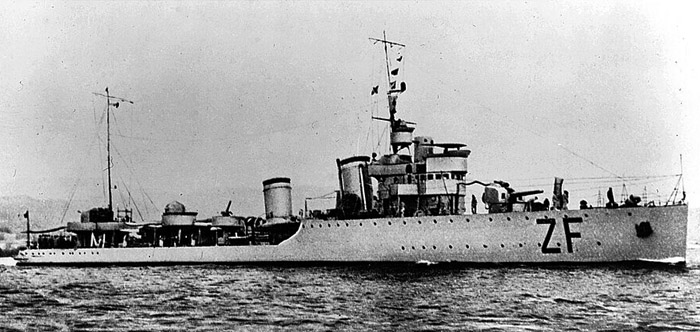
Zeffiro was laid down at Ansaldo on 29 April 1925, launched on 9 June 1928, completed on 9 October. She wa spart of the 1st Squadron, I DF at La Spezia, hit in exercises by a defective torpedo from Aquilone. In 1931 she was in the II Naval Division, 1934 4th DS, II ND. With the Civil War in Spain, from 3 August 1937 she was sent to intercept a convoy from Odessa, participated in several patrols with Euro, but spotted no suspecious ship. Operations ceased in September. By 10 June 1940, with Espero, Ostro and Borea she was in the 2nd DS, Taranto. On 27 June she left Taranto with Ostro and Espero to Tobruk with reinforcements and military loads and were caught on 28 June west of Zakynthos by the 7th Cruiser Squadron. See above for the details. She escaped and arrived on the 29th in Benghazi, then Tobruk on July 1. She escorted another convoy on 30 June from Augusta. On 5 July she was caught berthed by an air raid by nine Fairey Swordfish torpedo bombers of 813 Naval Air Squadron from Sidi Barrani, alarm raised at 20:06. The Destroyers had most of their personnel on the steamers Liguria and Sabbia but AA crew still on board. In the attack, five ships being sunk or damaged. Swordfish came at 100 feet to release their torpedoes from 400–500 meters away and Zeffiro was attacked first by Nicholas Kennedy, hitting her the bow, detonating the ammunition depot. She broke in two and sank 30 min. later with 21 casualties, 10 killed and 11 missing, 20 wounded.
Read More/Src
Books
Erminio Bagnasco e Enrico Cernuschi. Le navi da guerra italiane 1940-1945. Parma, Ermanno Albertelli Editore, 2005
Links
on navypedia.org/
navweaps.com/ Italian guns
navweaps.com 47mm/45 m1918
web.archive.org danieleranocchia.it
trentoincina.it/
trentoincina.it/
trentoincina.it/ Euro
trentoincina.it Turbine
trentoincina.it/
trentoincina.it/
en.wikipedia.org/ Turbine-class destroyer
it.wikipedia.or /Classe_Turbine
commons.wikimedia.org turbine
In video games (Wargaming)



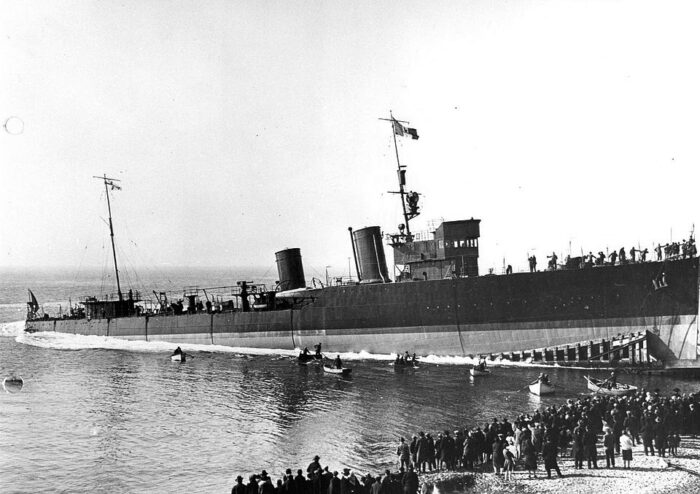
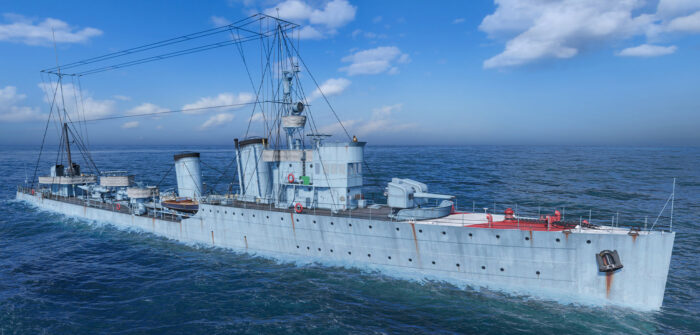
 Latest Facebook Entry -
Latest Facebook Entry -  X(Tweeter) Naval Encyclopedia's deck archive
X(Tweeter) Naval Encyclopedia's deck archive Instagram (@navalencyc)
Instagram (@navalencyc)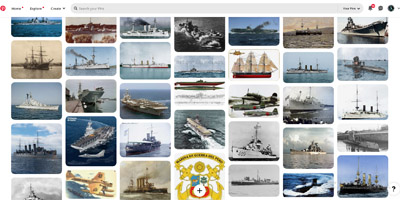

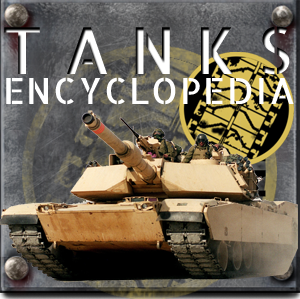
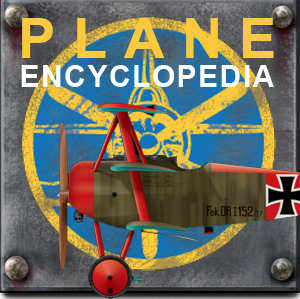
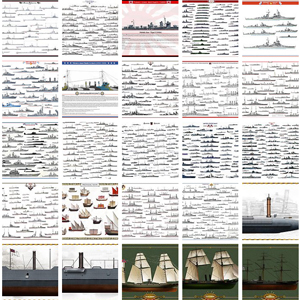
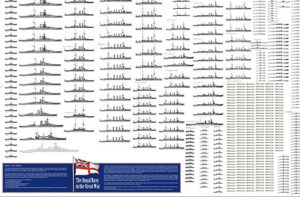
 French Navy
French Navy Royal Navy
Royal Navy Russian Navy
Russian Navy Armada Espanola
Armada Espanola Austrian Navy
Austrian Navy K.u.K. Kriegsmarine
K.u.K. Kriegsmarine Dansk Marine
Dansk Marine Nautiko Hellenon
Nautiko Hellenon Koninklije Marine 1870
Koninklije Marine 1870 Marinha do Brasil
Marinha do Brasil Osmanlı Donanması
Osmanlı Donanması Marina Do Peru
Marina Do Peru Marinha do Portugal
Marinha do Portugal Regia Marina 1870
Regia Marina 1870 Nihhon Kaigun 1870
Nihhon Kaigun 1870 Preußische Marine 1870
Preußische Marine 1870 Russkiy Flot 1870
Russkiy Flot 1870 Svenska marinen
Svenska marinen Søværnet
Søværnet Union Navy
Union Navy Confederate Navy
Confederate Navy Armada de Argentina
Armada de Argentina Imperial Chinese Navy
Imperial Chinese Navy Marinha do Portugal
Marinha do Portugal Mexico
Mexico Kaiserliche Marine
Kaiserliche Marine 1898 US Navy
1898 US Navy Sovietskiy Flot
Sovietskiy Flot Royal Canadian Navy
Royal Canadian Navy Royal Australian Navy
Royal Australian Navy RNZN Fleet
RNZN Fleet Chinese Navy 1937
Chinese Navy 1937 Kriegsmarine
Kriegsmarine Chilean Navy
Chilean Navy Danish Navy
Danish Navy Finnish Navy
Finnish Navy Hellenic Navy
Hellenic Navy Polish Navy
Polish Navy Romanian Navy
Romanian Navy Turkish Navy
Turkish Navy Royal Yugoslav Navy
Royal Yugoslav Navy Royal Thai Navy
Royal Thai Navy Minor Navies
Minor Navies Albania
Albania Austria
Austria Belgium
Belgium Columbia
Columbia Costa Rica
Costa Rica Cuba
Cuba Czechoslovakia
Czechoslovakia Dominican Republic
Dominican Republic Haiti
Haiti Hungary
Hungary Honduras
Honduras Estonia
Estonia Iceland
Iceland Eire
Eire Equador
Equador Iran
Iran Iraq
Iraq Latvia
Latvia Liberia
Liberia Lithuania
Lithuania Mandchukuo
Mandchukuo Morocco
Morocco Nicaragua
Nicaragua Persia
Persia San Salvador
San Salvador Sarawak
Sarawak Uruguay
Uruguay Venezuela
Venezuela Zanzibar
Zanzibar Warsaw Pact Navies
Warsaw Pact Navies Bulgaria
Bulgaria Hungary
Hungary

 Bundesmarine
Bundesmarine Dutch Navy
Dutch Navy Hellenic Navy
Hellenic Navy Marina Militare
Marina Militare Yugoslav Navy
Yugoslav Navy Chinese Navy
Chinese Navy Indian Navy
Indian Navy Indonesian Navy
Indonesian Navy JMSDF
JMSDF North Korean Navy
North Korean Navy Pakistani Navy
Pakistani Navy Philippines Navy
Philippines Navy ROKN
ROKN Rep. of Singapore Navy
Rep. of Singapore Navy Taiwanese Navy
Taiwanese Navy IDF Navy
IDF Navy Saudi Navy
Saudi Navy Royal New Zealand Navy
Royal New Zealand Navy Egyptian Navy
Egyptian Navy South African Navy
South African Navy






























 Ukrainian Navy
Ukrainian Navy dbodesign
dbodesign
The details about the Battle of the Espero Convoy are not correct.
The Espero was not struck by the first salvoes (fire was opened by the British cruisers at around 1835h, she was finally hit at around 2000h); rather, she had boiler issues that prevented her from making full speed. That is why Baroni ordered the other ships to flee and sacrificed himself and his ship to cover them.
Also, it should be mentioned that some five thousand 6″ shell were expended to sink her. An absurd price to pay for an obsolescent destroyer in absolute terms, but also one that forced a delay in RN operations until stores could be replenished. Arguably a RN operational defeat.
Thx for your point, i exposed the whole battle in the full career of Espero lower in the article.